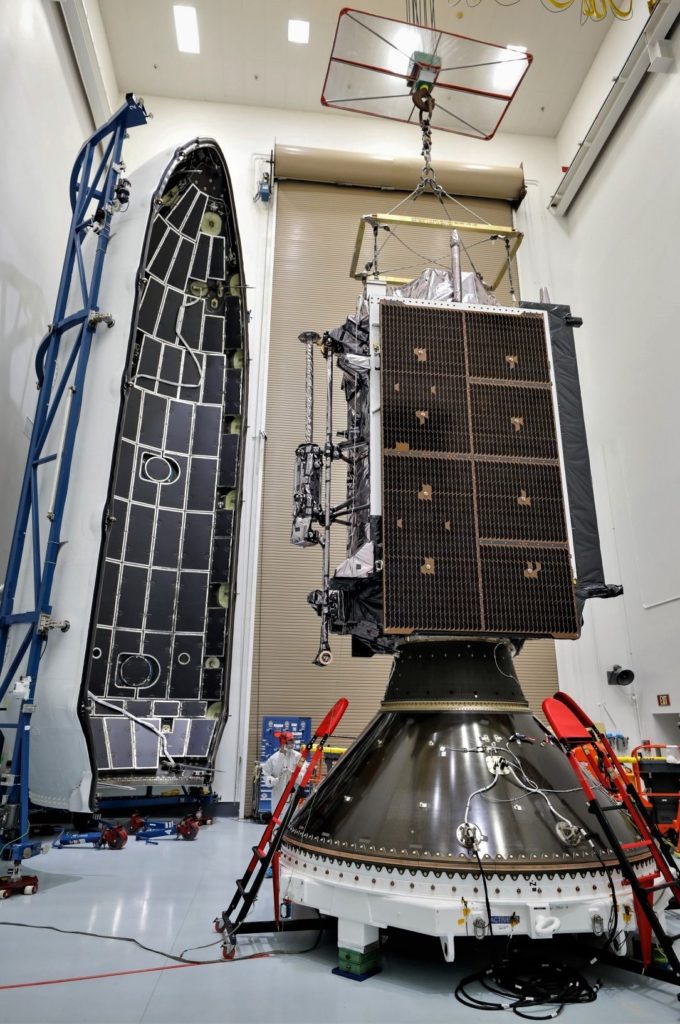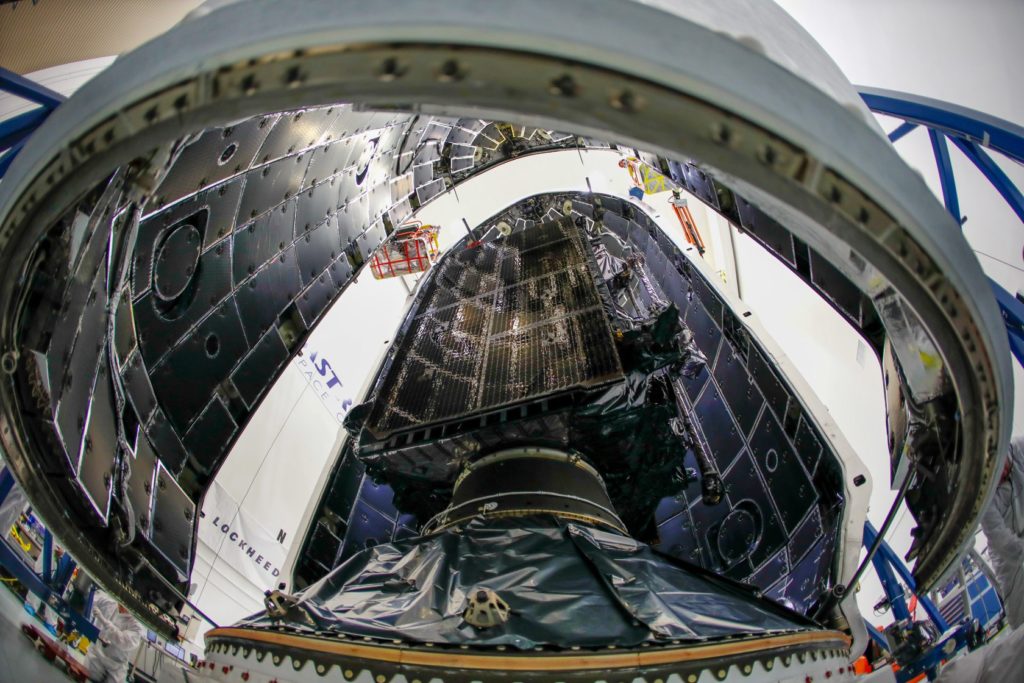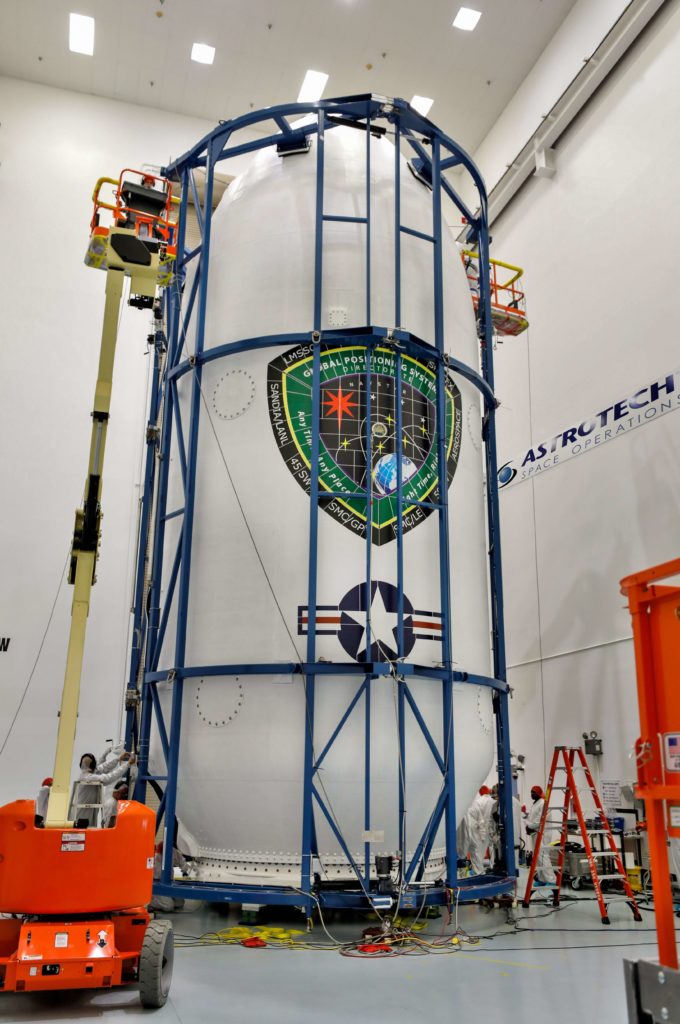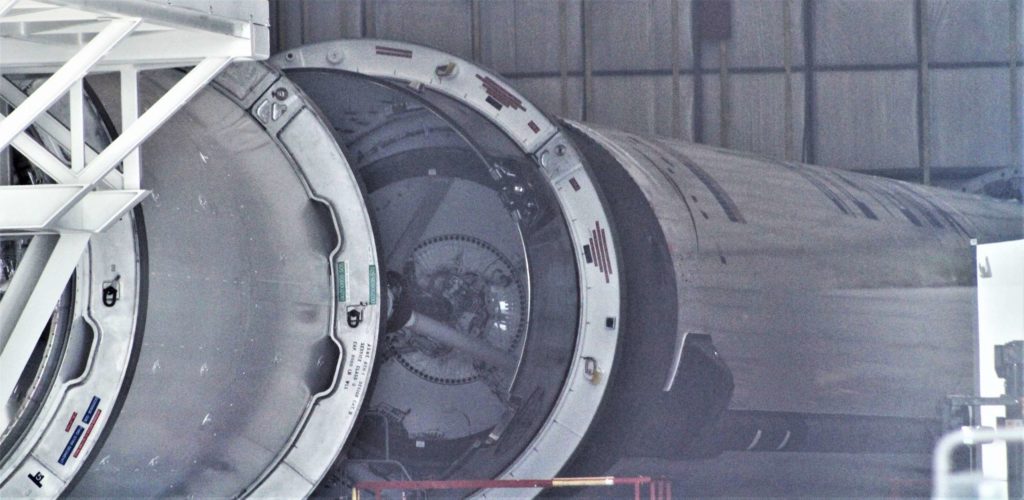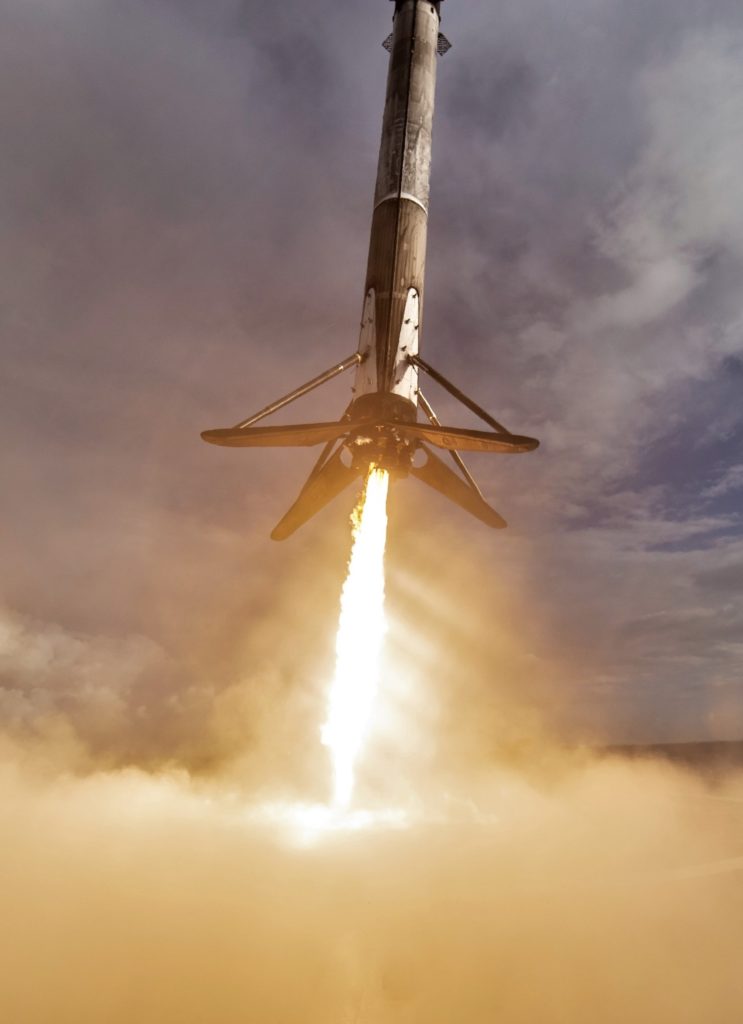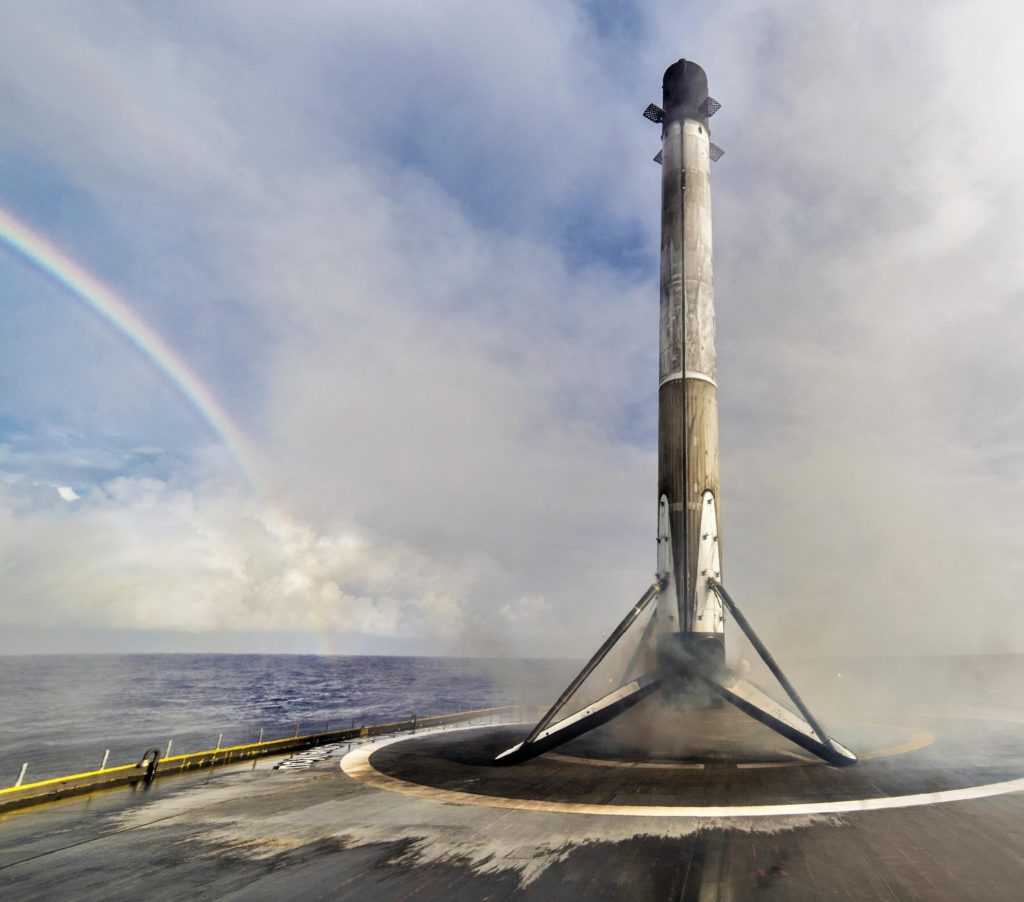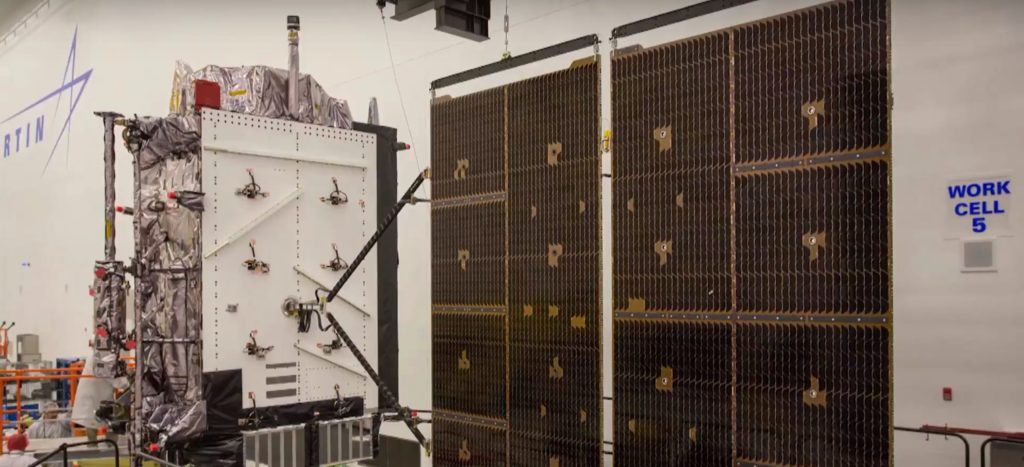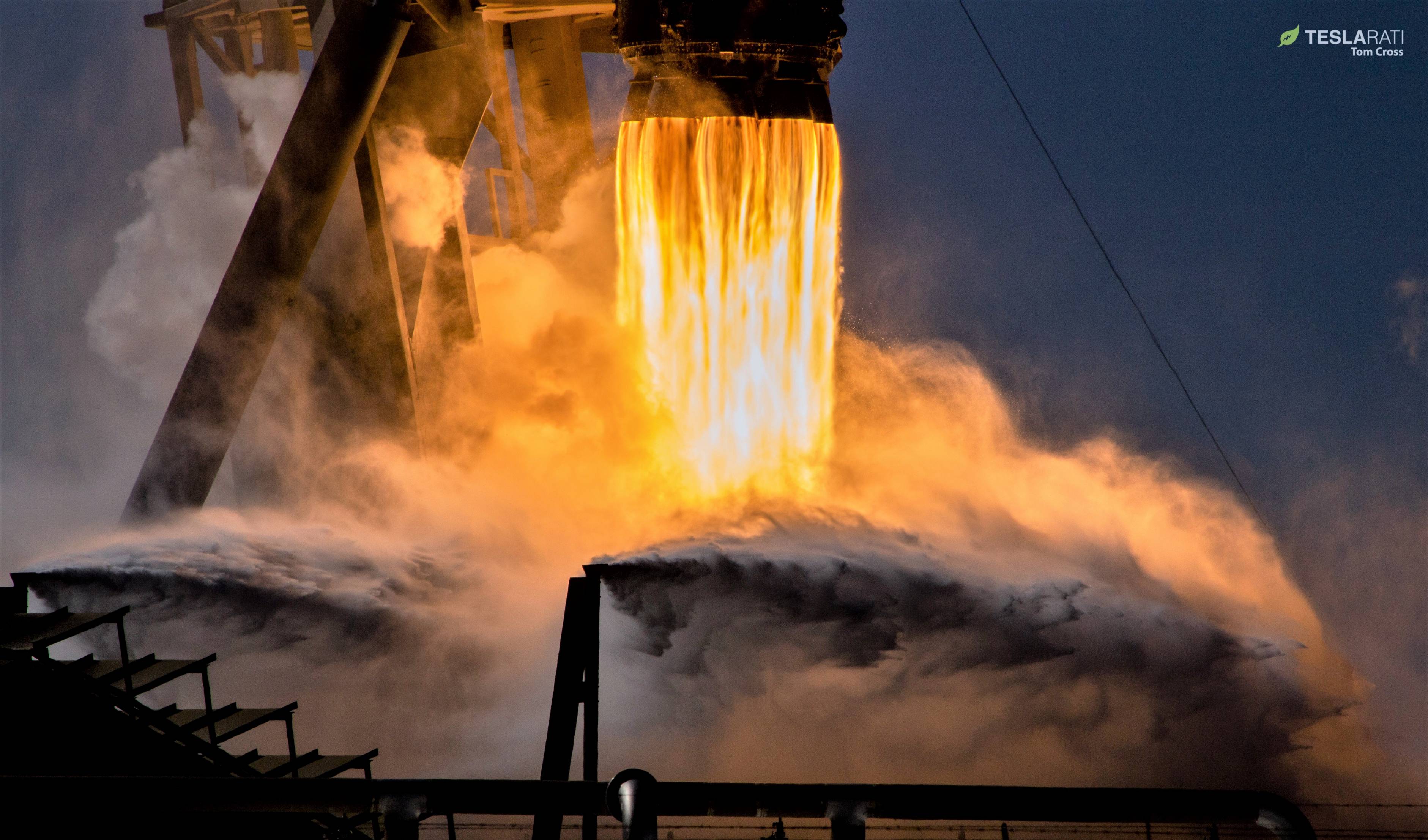

News
SpaceX’s Falcon 9 Block 5 set for first expendable launch with USAF satellite
SpaceX’s most significant US Air Force launch contract yet is set to kick off with a (NET) December 18 launch of the first of 10 next-gen GPS satellites, known as GPS III Space Vehicle 1 (SV01). Thus far, SpaceX has won all five competitive GPS III launch contracts offered thus far by the USAF and – depending on Falcon 9’s performance this launch – could win several more.
Aside from contract victories, SpaceX’s first GPS III launch will be marked by yet another first for the company’s May 2018-debuted Falcon 9 Block 5 rocket. This first is not quite as desirable, though: sans landing legs and titanium grid fins, the new Block 5 booster will be expended after launch and will make no attempt to land.
Via @USAirForce: First GPS III satellite, AKA “Vespucci,” encapsulated in fairing on 12/7 ahead of #SpaceX Falcon 9 launch NET 12/18. This is the company’s first GPS mission and is expendable, so there will be no booster recovery.
(📸: @LockheedMartin) pic.twitter.com/5aOWy1tI5k
— Emre Kelly (@EmreKelly) December 11, 2018
At this point in time, the first official confirmation that Falcon 9 will be flying in an expendable configuration was given in a handful of comments made by Vice President of Launch and Build Reliability Hans Koenigsmann at a Dec. 5 press conference. While focused primarily on the topic at hand (SpaceX’s successful launch of the CRS-16 Cargo Dragon), members of the press managed to squeeze in a few minimally related questions which Hans graciously answered. Speaking about SpaceX’s imminent GPS III launch, Hans noted that,
“GPS is not landing a booster. It doesn’t have the landing hardware, or the majority of the landing hardware. … I looked at the booster yesterday, it’s in great shape and getting integrated in the hangar.
- GPS III SV01 is encapsulated in Falcon 9’s fairing. (SpaceX)
- GPS III SV01 is encapsulated in Falcon 9’s fairing. (SpaceX)
- GPS III SV01 is encapsulated in Falcon 9’s fairing. (SpaceX)
- Spotted by local photographer Tom McCool on November 27th, this 39A-located Falcon 9 booster is the likeliest candidate for the first GPS III launch. (Tom McCool)
Hans also told members of the audience that he believed the expendable profile had stemmed from a customer (i.e. USAF) requirement based on a need for extra performance:
“Regarding GPS not landing, I think this is a customer requirement to have all the performance for the mission. It’s a challenging mission.“
While there was previously some doubt as to whether Falcon 9 was actually incapable of attempting a booster landing after launch, Mr. Koenigsmann’s offhand suggestion that GPS III launches would be “challenging mission[s]” makes it far more likely that the USAF’s given mission profile genuinely demands all of Falcon 9’s performance – not enough propellant will remain for Falcon 9 to attempt recovery. There is, however, still some ambiguity in Hans’ answer.
If Falcon 9 will be expended solely as a consequence of mission performance requirements despite the oddly low payload mass (~3800 kg) and comparatively low-energy orbit (~20,000 km), the only possible explanation for no attempted recovery would be the need for Falcon 9’s upper stage to perform a lengthy second burn after a long coast in orbit. However, the mission parameters the USAF shopped around for would have placed the GPS III satellite into an elliptical orbit of 1000 km by 20,181 km, an orbit that would unequivocally allow Falcon 9 to attempt a drone ship recovery.
- Falcon 9 B1047.2 is seen here conducting its second successful drone ship landing. (SpaceX)
- In a more perfect world, Falcon 9 would have been responsible for the rainbow. (SpaceX)
- Lockheed Martin’s GPS III (SV 01-10) satellite.
- A GPS III spacecraft spreads one of its solar array wings. (USAF)
The reasoning behind this is simple: SpaceX routinely recovers Falcon 9 boosters after far more energetic launches. For example, Falcon 9’s November 15th launch placed the 5300 kg Es’hail-2 satellite into an orbit of 200 km by 37,700 km, after which Falcon 9 B1047.2 performed its second successful landing on drone ship Of Course I Still Love You. A prevailing second theory for the expendable mission lies in the Air Force’s notoriously stodgy and sometimes irrational revulsion at the slightest hint of risk or change – to minimize perceived risk, the USAF could have thus demanded that SpaceX expend Falcon 9 regardless of whether it was capable of doing so.
For GPS III SV01, it appears that only time will tell whether the satellite ends up in an orbit that can properly explain the booster’s premature demise. Given that SpaceX has a full four additional GPS III launches currently on the books, it will be a shame to see a veritable fleet of Falcon 9 Block 5 boosters tossed into the sea after just a single launch each.
For prompt updates, on-the-ground perspectives, and unique glimpses of SpaceX’s rocket recovery fleet check out our brand new LaunchPad and LandingZone newsletters!
News
Tesla UK sales see 14% year-over-year rebound in June: SMMT data
The SMMT stated that Tesla sales grew 14% year-over-year to 7,719 units in June 2025.

Tesla’s sales in the United Kingdom rose in June, climbing 14% year-over-year to 7,719 units, as per data from the Society of Motor Manufacturers and Traders (SMMT). The spike in the company’s sales coincided with the first deliveries of the updated Model Y last month.
Model Y deliveries support Tesla’s UK recovery
Tesla’s June performance marked one of its strongest months in the UK so far this year, with new Model Y deliveries contributing significantly to the company’s momentum.
While the SMMT listed Tesla with 7,719 deliveries in June, independent data from New AutoMotive suggested that the electric vehicle maker registered 7,891 units during the month instead. However, year-to-date figures for Tesla remain 2% down compared to 2024, as per a report from Reuters.
While Tesla made a strong showing in June, rivals are also growing. Chinese automaker BYD saw UK sales rise nearly fourfold to 2,498 units, while Ford posted the highest EV growth among major automakers, with a more than fourfold increase in the first half of 2025.
Overall, the UK’s battery electric vehicle (BEV) demand surged 39% to to 47,354 units last month, helping push total new car sales in the UK to 191,316 units, up 6.7% from the same period in 2024.
EV adoption accelerates, but concerns linger
June marked the best month for UK car sales since 2019, though the SMMT cautioned that growth in the electric vehicle sector remains heavily dependent on discounting and support programs. Still, one in four new vehicle buyers in June chose a battery electric vehicle.
SMMT Chief Executive Mike Hawes noted that despite strong BEV demand, sales levels are still below regulatory targets. “Further growth in sales, and the sector will rely on increased and improved charging facilities to boost mainstream electric vehicle adoption,” Hawes stated.
Also taking effect this week was a new US-UK trade deal, which lowers tariffs on UK car exports to the United States from 27.5% to 10%. The agreement could benefit UK-based EV producers aiming to expand across the country.
News
Tesla Model 3 ranks as the safest new car in Europe for 2025, per Euro NCAP tests
Despite being on the market longer than many of its rivals, the Tesla Model 3 continues to set the bar for vehicle safety.

The Tesla Model 3 has been named the safest new car on sale in 2025, according to the latest results from the Euro NCAP. Among 20 newly tested vehicles, the Model 3 emerged at the top of the list, scoring an impressive 359 out of 400 possible points across all major safety categories.
Tesla Model 3’s safety systems
Despite being on the market longer than many of its rivals, the Tesla Model 3 continues to set the bar for vehicle safety. Under Euro NCAP’s stricter 2025 testing protocols, the electric sedan earned 90% for adult occupant protection, 93% for child occupant protection, 89% for pedestrian protection, and 87% for its Safety Assist systems.
The updated Model 3 received particular praise for its advanced driver assistance features, including Tesla’s autonomous emergency braking (AEB) system, which performed well across various test scenarios. Its Intelligent Speed Assistance and child presence detection system were cited as noteworthy features as well, as per a WhatCar report.
Other notable safety features include the Model 3’s pedestrian-friendly pop-up hood and robust crash protection for both front and side collisions. Euro NCAP also highlighted the Model 3’s ability to detect vulnerable road users during complex maneuvers, such as turning across oncoming traffic.
Euro NCAP’s Autopilot caution
While the Model 3’s safety scores were impressive across the board, Euro NCAP did raise concerns about driver expectations of Tesla’s Autopilot system. The organization warned that some owners may overestimate the system’s capabilities, potentially leading to misuse or inattention behind the wheel. Even so, the Model 3 remained the highest-scoring vehicle tested under Euro NCAP’s updated criteria this year.
The Euro NCAP’s concerns are also quite interesting because Tesla’s Full Self-Driving (FSD) Supervised, which is arguably the company’s most robust safety suite, is not allowed for public rollout in Europe yet. FSD Supervised would allow the Model 3 to navigate inner city streets with only minimal human supervision.
Other top scorers included the Volkswagen ID.7, Polestar 3, and Geely EX5, but none matched the Model 3’s total score or consistency across categories. A total of 14 out of 20 newly tested cars earned five stars, while several models, including the Kia EV3, MG ZS, and Renault 5, fell short of the top rating.
Elon Musk
Why Tesla’s Q3 could be one of its biggest quarters in history
Tesla could stand to benefit from the removal of the $7,500 EV tax credit at the end of Q3.

Tesla has gotten off to a slow start in 2025, as the first half of the year has not been one to remember from a delivery perspective.
However, Q3 could end up being one of the best the company has had in history, with the United States potentially being a major contributor to what might reverse a slow start to the year.
Earlier today, the United States’ House of Representatives officially passed President Trump’s “Big Beautiful Bill,” after it made its way through the Senate earlier this week. The bill will head to President Trump, as he looks to sign it before his July 4 deadline.
The Bill will effectively bring closure to the $7,500 EV tax credit, which will end on September 30, 2025. This means, over the next three months in the United States, those who are looking to buy an EV will have their last chance to take advantage of the credit. EVs will then be, for most people, $7,500 more expensive, in essence.
The tax credit is available to any single filer who makes under $150,000 per year, $225,000 a year to a head of household, and $300,000 to couples filing jointly.
Ending the tax credit was expected with the Trump administration, as his policies have leaned significantly toward reliance on fossil fuels, ending what he calls an “EV mandate.” He has used this phrase several times in disagreements with Tesla CEO Elon Musk.
Nevertheless, those who have been on the fence about buying a Tesla, or any EV, for that matter, will have some decisions to make in the next three months. While all companies will stand to benefit from this time crunch, Tesla could be the true winner because of its sheer volume.
If things are done correctly, meaning if Tesla can also offer incentives like 0% APR, special pricing on leasing or financing, or other advantages (like free Red, White, and Blue for a short period of time in celebration of Independence Day), it could see some real volume in sales this quarter.
You can now buy a Tesla in Red, White, and Blue for free until July 14 https://t.co/iAwhaRFOH0
— TESLARATI (@Teslarati) July 3, 2025
Tesla is just a shade under 721,000 deliveries for the year, so it’s on pace for roughly 1.4 million for 2025. This would be a decrease from the 1.8 million cars it delivered in each of the last two years. Traditionally, the second half of the year has produced Tesla’s strongest quarters. Its top three quarters in terms of deliveries are Q4 2024 with 495,570 vehicles, Q4 2023 with 484,507 vehicles, and Q3 2024 with 462,890 vehicles.
-

 Elon Musk4 days ago
Elon Musk4 days agoTesla investors will be shocked by Jim Cramer’s latest assessment
-

 News1 week ago
News1 week agoTesla Robotaxi’s biggest challenge seems to be this one thing
-

 Elon Musk2 weeks ago
Elon Musk2 weeks agoFirst Look at Tesla’s Robotaxi App: features, design, and more
-

 News2 weeks ago
News2 weeks agoSpaceX and Elon Musk share insights on Starship Ship 36’s RUD
-

 News2 weeks ago
News2 weeks agoWatch Tesla’s first driverless public Robotaxi rides in Texas
-

 News1 week ago
News1 week agoWatch the first true Tesla Robotaxi intervention by safety monitor
-

 News2 weeks ago
News2 weeks agoTesla has started rolling out initial round of Robotaxi invites
-

 Elon Musk2 weeks ago
Elon Musk2 weeks agoTesla to launch in India in July with vehicles already arriving: report

